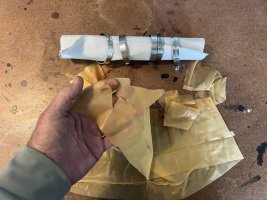I second all that is said here. A little drip underway on a conventional packing is just fine and, for goodness sake, leave it alone. I use the green clay stuff on my boats to achieve dripless results that has lasted for years, but I don't actually recommend it to most folks because it requires a very clean and entirely smooth shaft (new is best) and quite a bit of fussing with nut tension to get it perfect (completely dry and not producing heat). In Maine, this is the preferred solution for the lobster boats (which is where I learned to do it--though the instructions in the kit are clear and correct). Once set, mine has been running cool and dry for the last 10 years. I could do a video on this (I don't think there is one on Youtube yet) but I really do not want to deal with folks with scored shafts and those who are not willing to fuss with the settings for the first 30 hours--it is a fussy job requiring patience. Sounds like you have a well set, very traditional packing situation and I would stick with that for now. If you have to replace it, I have done it in the water. It is a bit wet (use a towel) and a terrible time to be learning how to do it (there are excellent videos on Youtube about how to remove ALL the old packing--which is the key). For some reason the Ericson Owners manual specifies 1/8"packing on a 1" shaft--I know of no professional boatyard that would agree with that. On a 1" shaft you need some 3/16" rings (I carry them pre cut as spares) and some Syntec grease. It would be good to cut some rings that fit your shaft and watch a Youtube video as a kind of safety drill--to be prepared. I have no safety advice for folks with the PSS mechanical seals. You just need to have a towel to sacrifice (been there done that) and hope you are near a Travel lift before the leak overwhelms your bilge pump. I understand the new models of PSS seals are significantly improved, but they still are not adjustable or repairable underway. I believe the packing gland should be checked as a regular part of start up and shut down--generally the designers make sure to make this extremely difficult if not impossible, a huge problem in production yachts.

